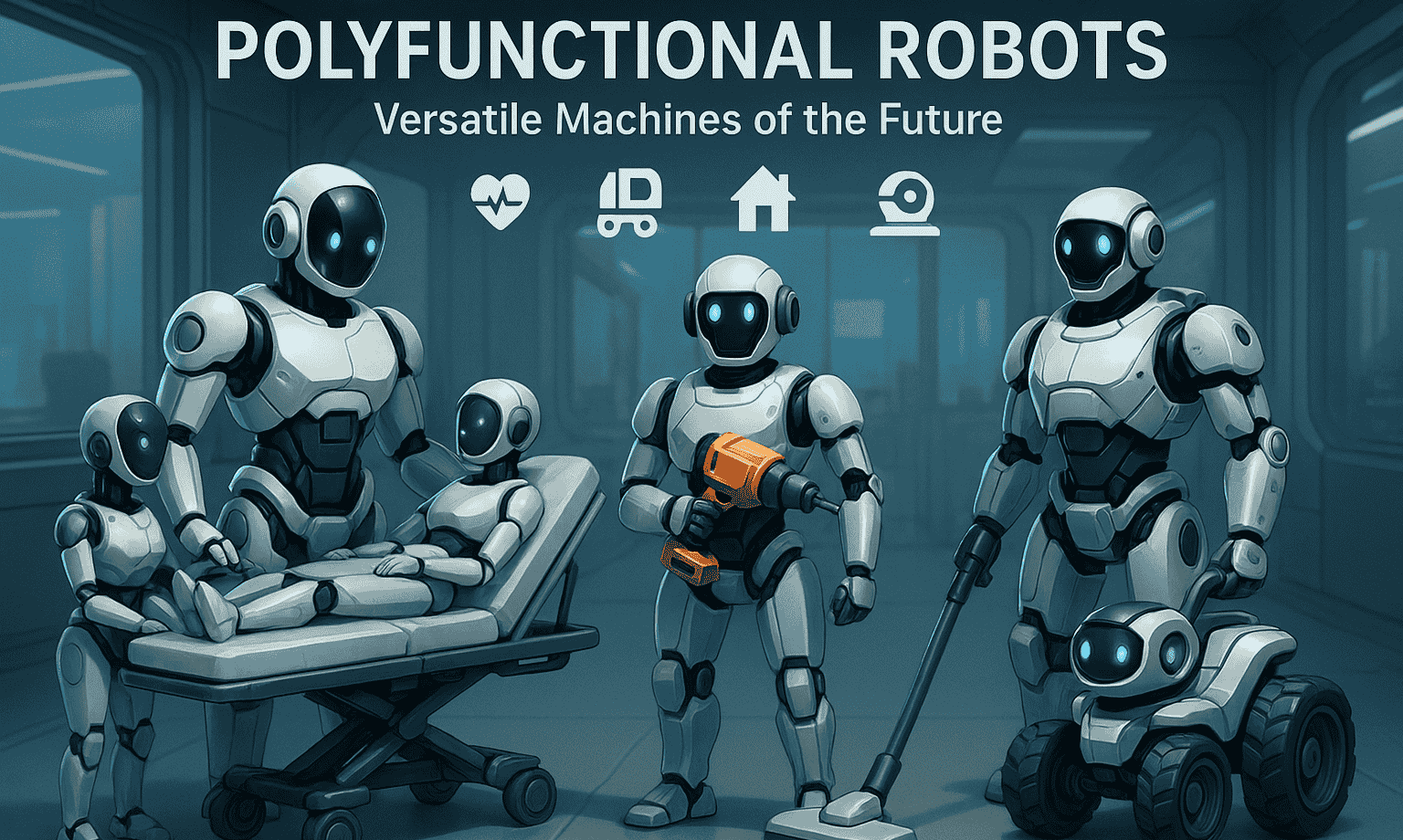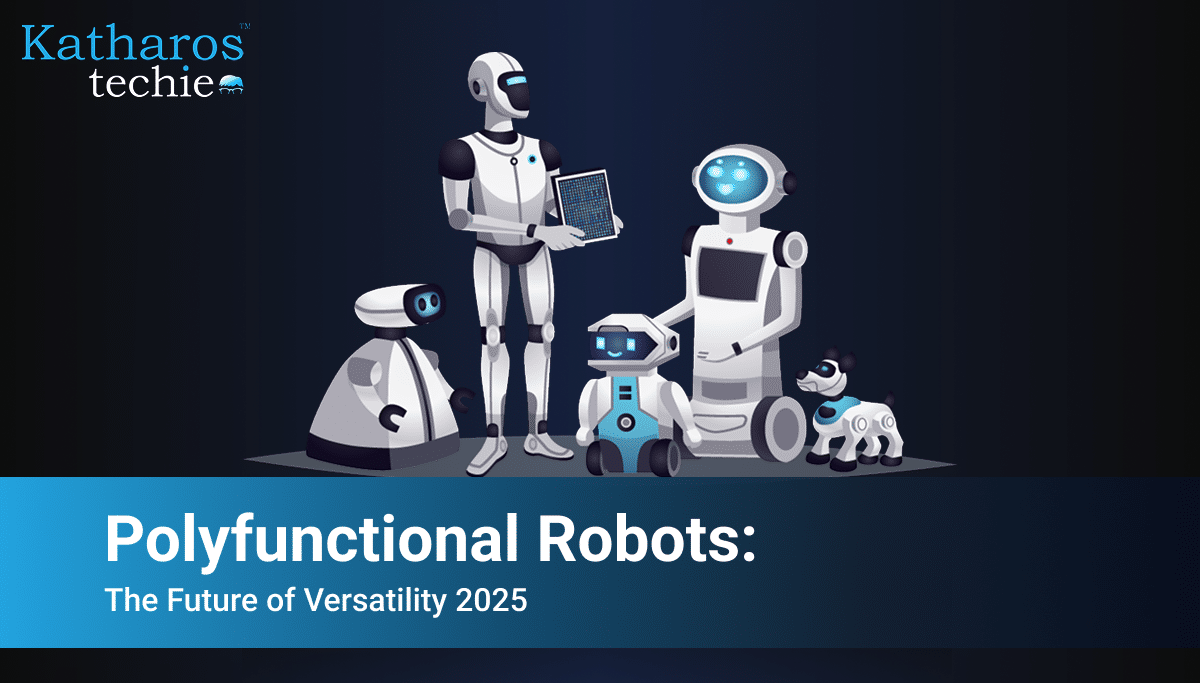The Rise of the Adaptive Machine
Robots have long been a cornerstone of automation — performing repetitive tasks with precision and speed. But the world is changing fast, and the demand for flexible, intelligent, and collaborative machines is reshaping what robotics can do.
Enter the era of polyfunctional robots — also known as adaptive robotics. These are robots that can perform multiple tasks, adapt to new environments, and collaborate safely with humans. According to Gartner’s 2025 Strategic Technology Trends, polyfunctional robotics is one of the most transformative developments to watch in the coming years.
Driven by advances in sensors, actuators, reinforcement learning, soft robotics, and dexterous manipulation, these machines promise to bridge the gap between human adaptability and robotic efficiency.
In short, polyfunctional robots are no longer just tools — they’re intelligent partners in work, healthcare, exploration, and even daily life.
What Are Polyfunctional Robots?
The term “polyfunctional” refers to the ability to perform multiple distinct functions using the same hardware platform. Unlike traditional robots built for one repetitive task, these new systems can learn, adapt, and switch between different tasks dynamically.
Key Characteristics
-
Task Flexibility:
A polyfunctional robot can perform various tasks — for instance, sorting parts, assembling components, and assisting human workers — all without major reprogramming. -
Adaptive Intelligence:
Through machine learning and reinforcement learning, the robot continuously improves based on feedback and changing conditions. -
Human Collaboration (Cobots):
These robots are designed to work safely alongside humans, sharing workspace and cooperating in real time. -
Environmental Awareness:
Equipped with advanced sensors, they can perceive their surroundings, avoid obstacles, and respond to unexpected situations. -
Self-Optimization:
Using AI, they can analyze their performance, detect inefficiencies, and adjust motion or energy use autonomously.
The Technology Behind Adaptive Robotics
Modern adaptive robots integrate multiple technologies across mechanical, electrical, and software domains.
1. Sensors and Perception Systems
High-resolution LIDAR, vision cameras, tactile sensors, and radar arrays allow robots to perceive the environment in 3D.
These sensors provide real-time data for navigation, manipulation, and human-robot interaction — making robots aware, safe, and context-sensitive.
2. Actuators and Soft Robotics
Traditional robots use rigid actuators suited for precision but not for flexibility. Soft robotics introduces deformable materials and pneumatic systems that mimic muscles, enabling robots to handle fragile objects or move more naturally.
Examples include robotic grippers that can pick up an egg or medical robots that gently manipulate tissues.
3. Reinforcement Learning (RL)
Reinforcement learning allows robots to learn from trial and error, much like humans.
Instead of following hard-coded instructions, RL-based robots develop strategies to achieve goals efficiently by optimizing through experience.
4. Dexterous Manipulation
Using advanced control algorithms, robots now achieve fine motor skills — threading a needle, folding laundry, or performing surgery.
This ability to grasp, twist, and manipulate various objects without human recalibration marks a huge leap forward.
5. Edge Computing and AI Integration
AI algorithms now run on-device through edge computing, allowing real-time decision-making without relying on cloud latency.
This makes adaptive robots faster, more reliable, and more secure — crucial for industrial and healthcare settings.
From Industrial Robots to Polyfunctional Partners
For decades, robots in factories performed one job — welding, painting, or assembly. Retooling them for new tasks required days of programming and calibration. Polyfunctional robotics changes this entirely.
Industrial Applications
-
Manufacturing:
Polyfunctional robots can switch between assembling electronics one day and packaging goods the next, improving efficiency and reducing downtime. -
Logistics and Warehousing:
Adaptive robots navigate warehouses, restock shelves, and collaborate with human workers in dynamic environments.
Companies like Boston Dynamics, ABB, and Fanuc are developing robots capable of performing multiple logistics functions autonomously. -
Agriculture:
Adaptive robots are now capable of planting, watering, monitoring soil conditions, and harvesting crops — adjusting to terrain and weather variations. -
Construction:
Robots that can lay bricks, print structures, and inspect buildings bring flexibility to a traditionally labor-intensive industry.
Key Example: Cobots in Smart Manufacturing
Collaborative robots (cobots) represent the practical face of adaptive robotics in industry.
Unlike traditional robots that operate behind cages, cobots share workspace with humans, assisting in repetitive or heavy tasks while maintaining safety through sensors and smart algorithms.
Companies such as Universal Robots, KUKA, and Yaskawa are leading this movement — their cobots are used in automotive, electronics, and aerospace sectors to enhance productivity while protecting human workers.
Adaptive Robotics Beyond Industry
Polyfunctional robots are extending far beyond factory walls, entering sectors that demand empathy, mobility, and complex reasoning.
1. Healthcare and Elderly Assistance
Robots like Moxi (Diligent Robotics) and Pepper (SoftBank) assist medical staff, deliver supplies, and provide companionship to patients.
Advanced models can switch between tasks like disinfecting rooms, monitoring vitals, and interacting with patients conversationally.
In eldercare, adaptive robots help people with mobility challenges, ensuring safety while offering social interaction and cognitive support.
2. Disaster Response and Search & Rescue
Polyfunctional robots are invaluable in hazardous conditions — collapsing buildings, wildfires, or radiation zones.
They can switch from drone mode to ground mobility, identify victims, and assist in extraction using manipulators.
3. Space Exploration
NASA’s Robonaut and Astrobee robots aboard the International Space Station exemplify adaptive robotics in space.
They handle maintenance, experiments, and even assist astronauts — all autonomously adapting to microgravity.
4. Service and Retail Robots
AI-driven robots in restaurants, airports, and hotels can now take orders, deliver items, and clean — all with contextual awareness.
They can dynamically switch between tasks like serving customers and mapping new routes through crowded areas.
Benefits of Polyfunctional Robotics
The adoption of adaptive robotics brings benefits across industries and economies.
1. Increased Efficiency and Flexibility
Polyfunctional robots reduce downtime by eliminating reprogramming for new tasks.
Factories can pivot production faster — crucial in volatile markets.
2. Safety and Human Collaboration
Cobots handle dangerous, repetitive, or physically demanding work, protecting human workers while boosting overall productivity.
3. Scalability
Because they can learn and self-adapt, polyfunctional robots can be deployed across multiple industries without bespoke coding.
4. Cost Savings
One robot capable of many roles lowers equipment and maintenance costs, especially in small and medium enterprises.
5. Enhanced Learning Through AI
The more these robots operate, the smarter they get — sharing experiences through cloud-based learning networks that improve global fleets simultaneously.
Challenges to Overcome
Despite the promise, adaptive robotics faces several hurdles:
-
High Development Costs: Creating reliable multi-function systems requires complex hardware and AI integration.
-
Ethical & Employment Concerns: Automation may displace certain jobs, requiring reskilling programs and new workforce strategies.
-
Safety Regulations: Cobots operating near humans need rigorous safety certifications.
-
Standardization: Different industries need interoperable frameworks for robot communication and control.
Researchers and governments are actively addressing these issues through AI governance, human-in-the-loop design, and robot ethics frameworks.
The Future of Polyfunctional and Adaptive Robotics
The next decade will see robots evolve from fixed tools to dynamic collaborators with contextual intelligence and emotional awareness.
Emerging Trends
-
Self-Reconfiguring Robots:
Machines that can change shape or combine modules for different tasks — like a robot that transforms from a drone into a wheeled rover. -
Swarm Robotics:
Networks of small robots coordinating autonomously, inspired by insect colonies, for large-scale construction or search missions. -
AI-Integrated Manufacturing:
Factories where adaptive robots manage entire production lines, adjusting to supply chain changes instantly. -
Personal Assistive Robots:
Affordable household robots capable of cleaning, organizing, and providing companionship. -
Biohybrid Robotics:
Combining living cells with synthetic materials for self-healing, adaptive behavior, and unprecedented dexterity.
As Gartner forecasts, polyfunctional robotics will redefine how humans and machines interact, blurring the lines between automation and collaboration.
Intelligent Collaboration Is the Future
The evolution from single-purpose machines to polyfunctional, adaptive robots marks a major milestone in human innovation.
Fueled by breakthroughs in AI, reinforcement learning, sensors, and soft robotics, these intelligent machines will reshape industries, support human well-being, and accelerate productivity across the globe.
In the coming years, the question won’t be if robots can adapt — but how well they adapt to us.
The age of adaptive robotics has arrived — and it’s not about replacing humans, but empowering them through collaboration, precision, and shared intelligence.




